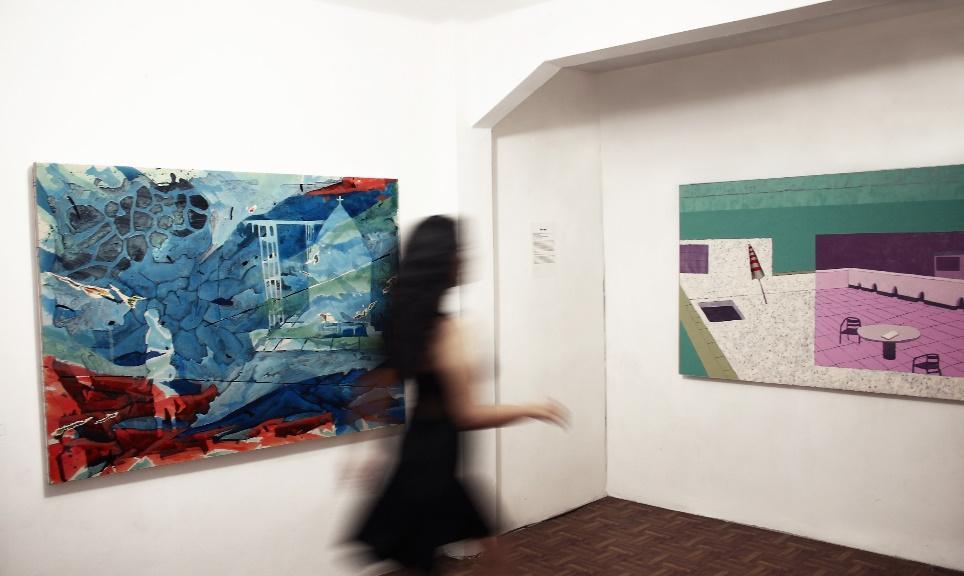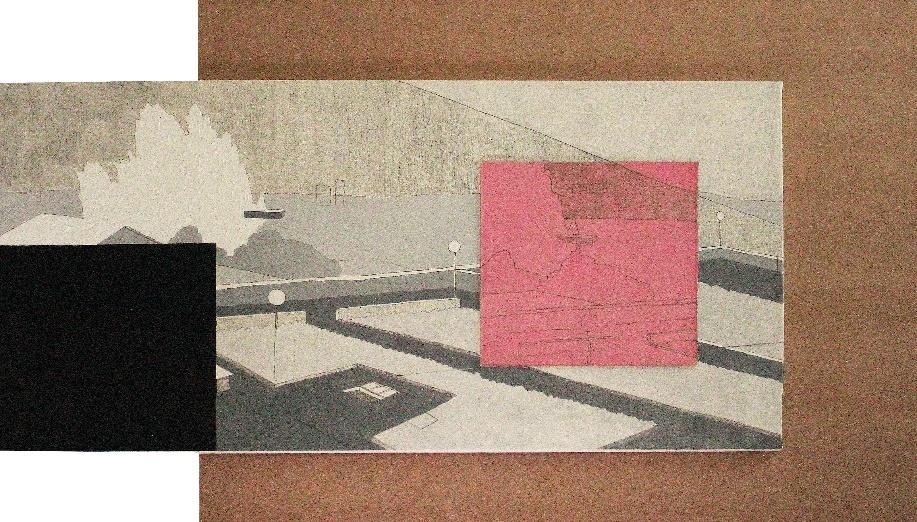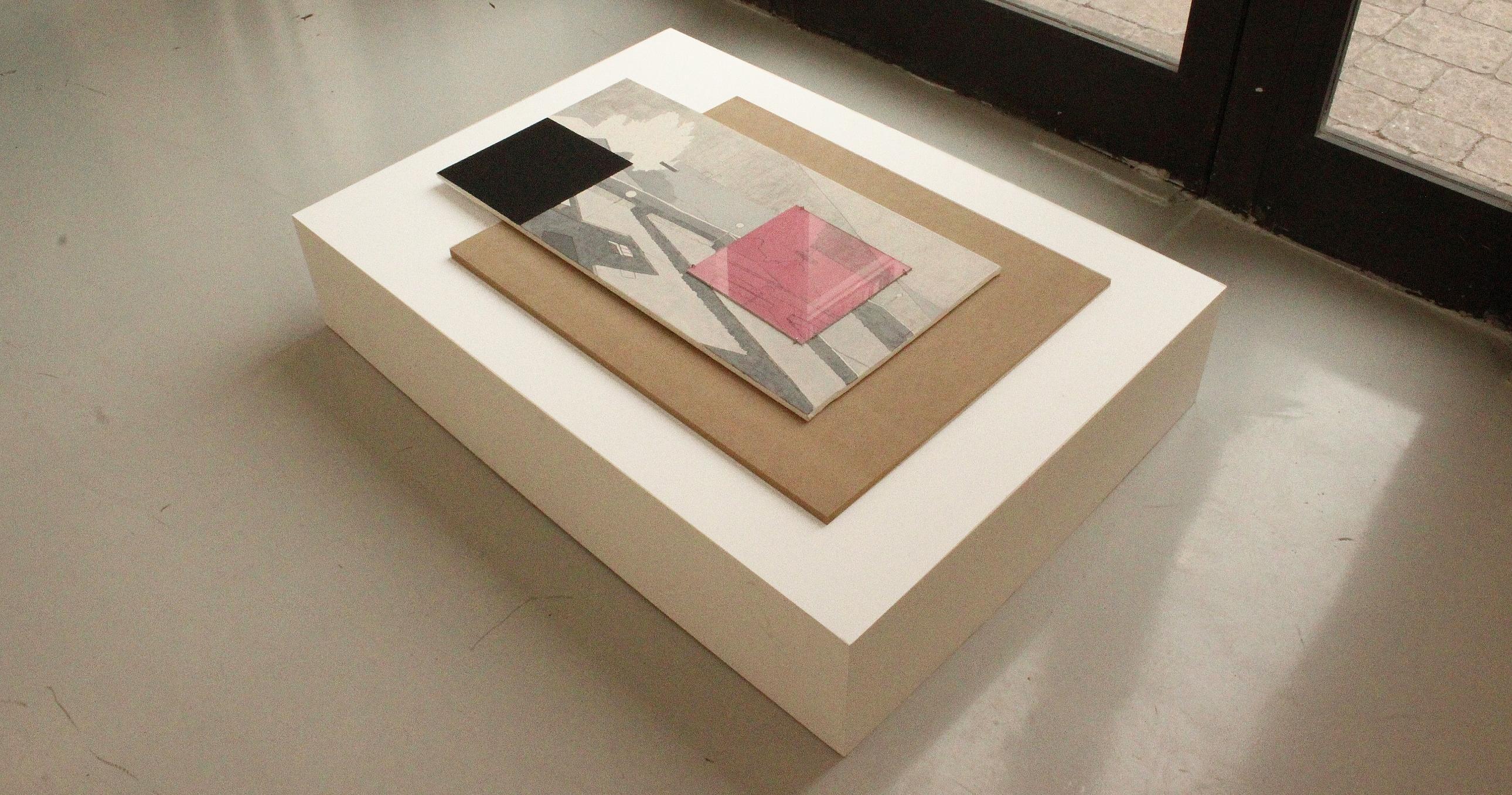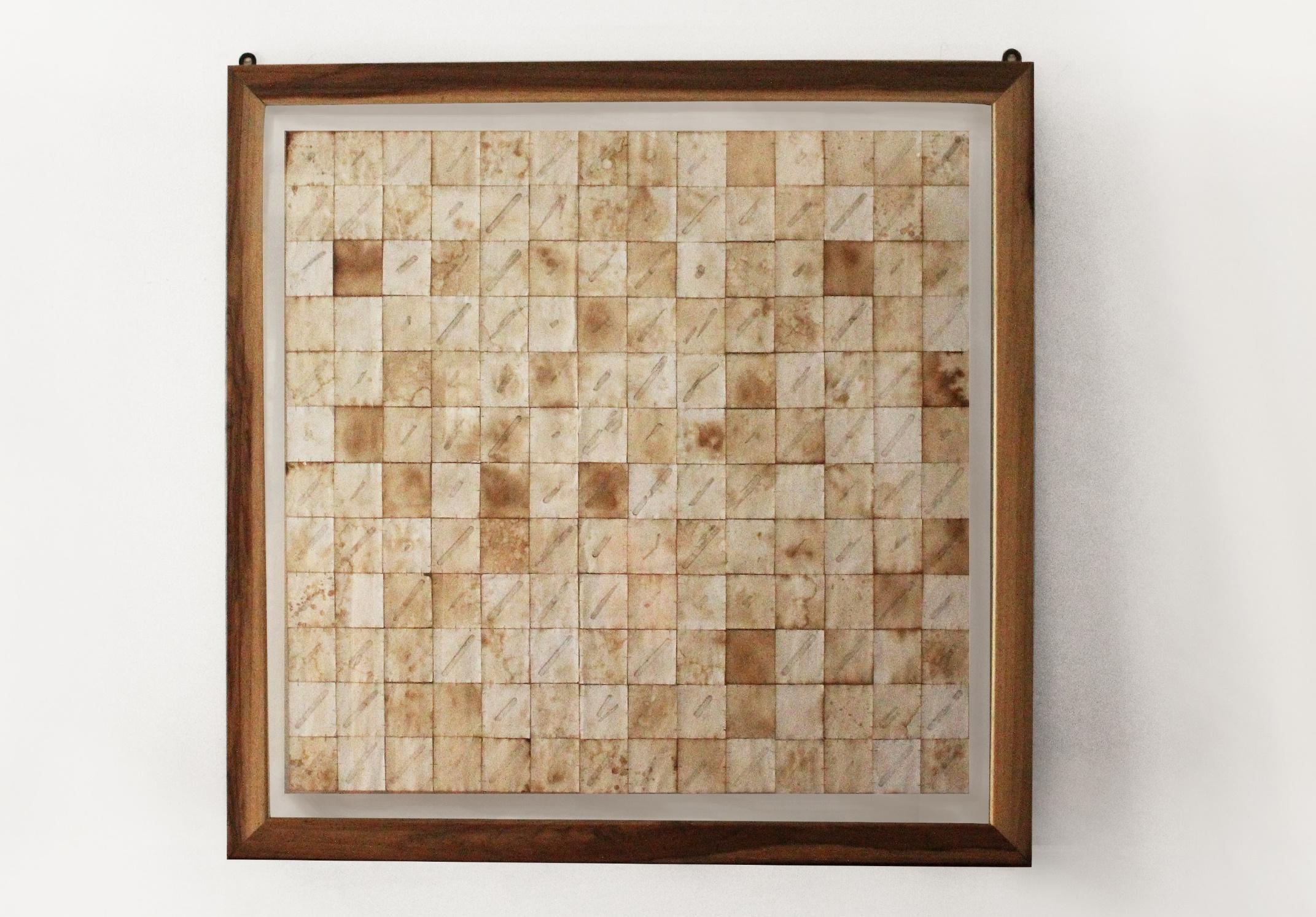F R A N C E S C A P A L M A T E R A N

(Ecuador, 1997)
My work is marked by a creative process that confronts, in a very personal way, the prominent flaws of visuality. In every project there is an eventual burning signal. Sometimes I combine reliefs or organic textures with graphics. The discursive lines that I explore in my proposals not only dialogue with optical inaccuracies, but also with the hidden meaning of reality.
It even problematizes the biological behavior of the eye: the faculty of seeing and the reflective will of the gaze. Attracted by its virtues and vulnerabilities, I venture into searches that involve the aesthetic power of the hierarchically organized image. Using digital tools, I build referential alternatives to unlock their manipulable potential. By reorganizing, copying, cutting and assembling, I end up finding maximum freedom in the creation space, to test ways to invert the meanings inherited in the images.
Thereby, I investigate the factors that influence the impact of vision and its subsequent seduction, in order to dissect their repertoires, narratives or fables.
In my last paintings made, the gradual introduction of the human figure has been inevitable. This is not far from notions about the optical. On the contrary, it is related to the senses of the individual. Expanding the concepts mainly discussed, the subject is represented and placed in the center of the perceived space. Simultaneously, by participating as a witness, what is observed is internalized in various ways, whether through memory, dreams and deep desires, imagination, sensitivity, immediate external world or the sum of all of them. However, for the most part this fantastic adventure will be reflections of it as it is a self-perception of the being itself.



Even in dreams you cry It is a 360° work that is presented as a double-sided image (bilateral sequence). It combines diverse investigations that delve into dream symbolism, particularly through the concept of Freudian self-sabotage on the part of the dreamer.
Therefore, it portrays a part of humankind's hidden nature, "what one does not want to confess to the self" (consciously). Lately, my interests have leaned toward playful narratives that emerge during the night: the shifting of thoughts and their incoherence, reflected in images that encapsulate those emotions. Although I believe it is considered an intimate and relatively subjective activity, it is interesting to see how this range of specters is made visible by the dreamer, and in this case, as a certain and profound emotion that haunts you even in your dreams.
Mp4 render: https://francescapalmateran.com/wp-content/uploads/2024/11/face0001-0300.mp4
Once I woke up, the world felt unknown and my body was no large part of it.

Oil on canvas, 205 x 400 cm (dimensions can be modified), 2024
Group exhibition: Multiverso II (Contemporary Art Center of Quito), Quito, Ecuador .
Once I woke up, the world felt unknown and my body was no large part of it It is a densely visual work that literally closes in and expands before the viewer, revealing itself as two versions of the same image. It seeks to show, through its two- and three-dimensional nature, a synthetic reality; that is, an uncontrolled fantasy, one could even call anarchic, or as others define it, "unconscious" and "incoherent."* In other words, this work fluctuates between introspection and Freud's methodology of realizing that the waking state (veglia) is a liar and an impostor, and that ultimately what is considered real is questioned as that probable deceptive fantasy,thusleavinga great lackofunderstandinginourself-perception.

Sometimes the darkness blinds me ��



No todas las rocas son montañas, Solo Show (2023)

No todas las rocas son montañas
(Not all rocks are mountains)
“You should enter this exhibition as if you were entering a place of the spirit, a medieval cathedral or a mountain. It must be done alone, concentrated and slowly.
Palma lived more than half of his life in Italy and saw these sculptural images daily on his tours of the city. The chosen motifs are marked by their experiences between continents, between cultures and between landscapes, and their works arise from a deep introspective work, like that carried out by the migrant, who, in contact with the other, returns to the existential question: who am I?
Her artistic productionthinksoflanguagesandlanguages astools of understanding and communication. The painted image of an angel in highreliefexpressesakindofambiguity,in thiscase gender,thatenables the viewer's involvement.
Theartistseeksthe sameeffectwhentitlingherworksin english, as for example in My perceptual field is full of reflections (2023) or The languages changes depending on strange conditions (2023). Inthis case, Palma looks for a language that, since it is neither Italian nor spanish, becomes more impersonal and functional, making her feel like another citizen of a globalized world. The image of the lion sculpture of the Cathedral ofSan Lorenzo inGenoa invitesusto enterthe exhibitionwith suspicion, it is a lion that cries and looks at us from above, its image is negativized to return to the feline vision and emphasize the difference between the ways of seeing things, that of the human being and that of the animal.



In her work, the human being is and is not there at the same time. There is her gaze, her gesture, her perception of landscapes, of natural elements, of light phenomena, or her spirituality embodied by the sculptures of Italian churches.
The artist is interested in the roughness and chiaroscuro effects that show the threedimensionality of her rocks, pointed and full of textures. These reliefs become protagonists in her pictorial work and activate the perception of the expectants, diverse beings that Palma imagines as human and non-human.
Palma builds her work at the limit of consciousness, where, as Freud says, what is repressed always comesbacktolifeandthenblossomsontheskin,like the hand tattoos that occupy the center of the rooms, as in a psychedelic vision by fluorescent colors.”


Too Soon
is based on a formal approach to the unreal relationship between organic lines vs lines of graphic representation (such as writing system or its translation in a modern font).
This linear ensemble starts from a random segment that has reference to a rocky organic texture where it has been inscribed by a coded language; The combination of light / shadow reveals the neutrality and absorption of a third landscape by which, through the mixture of those graphics, it adapts to the embossing technique where it allows to have a sculpted scanner of the different closed forms that constantly stimulate a sense of familiarity.
TOO SOON
Embossing technique on Fabriano 160g, 28 x 38 cm.


While we watch, something sees us
“The truth of the visible is an illusion. Its discredit has been progressive, from the moment that the “eye is no longer the one that preaches a «real world»”. Sight, which has always been considered the noblest ofthe senses,isusually powerlesswhen itcomesto perceivingthe universe that unfoldsbefore it. Appearances confined to visuality are responsible for the ambiguities that expand before vision. The gaze, in its audacity and autonomy, envelops us in cyclical traps, in its attempt to string together what is presumed to be real. This is known by Francesca Palma (1997), who in her personal ramblings lurks in those nooks where the prominent faults that hinder perceptive clairvoyance are installed. By exploring such abysses, she takes their fallible condition to relocate them in her paintings, retaining her feigned obstinacy. This is how the forms adopted resist being easily revealed.
In her landscapes she condenses the visual illusions that the images extracted from the infinity of the screens confer on us, incorporating elements that invite them to be found. The factors that stand out and are discriminated against are understood as “fractions of the real”, to use Palma’s expression. They are erratic versions, distanced representations of reality. The image, in its successive translations, transcends formats and dimensions, and throughout this process, perceived reality, the photographic image, the digital image and the painted image, can be glimpsed, generating a fracture in the traditional landscape genre. These resulting fragments are skillfully included as blind spots in the painting, leaving them suspended through lettering and embossing. This assemblage of languages, through which the materials and the invoice converse with the painting, activates and involves dialogues with the configurations of seeing in its optical unconsciousness.
In the paintings, sighted appearances are used, those hesitating and wavering, as Derrida understands it when she uses the terms “visible in-visible”; that which, without being “in sight”, remains in the “order of the visible”. That is, what is not reached by the trajectory of the gaze and is reduced to imperceptible moments. For the gaze, in its path, by discriminating the optical information, drowns out the visual forms that may be impregnated and filled with events. The insufficiency of sight in the face of blindness to the visible is a recurring symptom in our inhabited space, the one in which we exist with haste and agitation. The representations of the landscape that err on the real, in the sense in which Palma has detected it, constitute the evidence of the defects of human vision.When we can't see everything within our visual range, we canonly be wary of the deceptive nature of images and profane vision. For this reason, we can say with Merleau-Ponty that to see is to have distance. That is to say, to take the vision to its last power to cover the volume of the surrounding world. And it is possible to maintain with Foucault that "visibility is a trap".
Beyond the spectrum or the entity, on the threshold of the visible, there are elements that sometimes remain hidden from the eye. These visual fragments, which move as if they were ghosts under dynamics of absence and presence, are materials that eclipse vision. There is always more than what we see, and what we see is not all there is. Not being able to trust our own eyes, which do not see everythingvisible,wecanonlyassumewhatispresentedtousthroughasuspiciousandcautiousgaze."
Ariana Tigua Montenegro (Ecuador,1996) october,2023
While we wacth, something see us. in collaboration with the visual artist Omar Bereche, mixed on canvas. 143x 143 cm. 2021.



Wiederkehr des Verdrängten, (The return of the repressed)
on prepared cardboard / mixed on canvas, (Diptych) 30 x 54 cm / 15 x 15,5 cm , 2023



RESIDUAL IMAGE OF MYSELF , Mixed media on canson of 300 g, 55 x 65 cm.2021




Mutate is the compilation of events that no longer exist.
Through a pictorial approach between the imaginary and the real, a residual image that evidences the mutation of this polarity within one of the most active aspects of perception; the vision and therefore in painting. In this way, an indeterminate key landscape is developed for the treatment of the image, showing how we systematically absorb and internalize forms that consecutively, through mechanical processes, arrive at their discernment. Within this visual ecosystem, new elements (codes) are simultaneously created in a destructive way, and finally deployed, they will inhabit this object spectacle autonomously and hierarchically.
Mixed media on canvas, 200 x 236 cm. 2022

Seven Laws. Mixed on various supports., 22 x 224 cm *** Collective exhibition La Minga (Gallery), Quito/ EC. 2021.

SEVEN LAWS is the affirmative piece of my series Visual perception is circumscribed (¿) by which in seven different contexts rhetorically evidence sensations and dysfunctions generated, incessantly, by the human machine. Faced with the simple act of absorbing images, we find ourselves faced with countless functional agents that profitably accumulate to automate, destroy or exalt a fragment of what is observed and consequently in Seven Laws takes seven autonomous solids breaking away from this mechanical ecosystem.
ALREDEDOR DE NORTE.
From the series Visual perception is circumscribed (¿) Solo show - March 2021.

I know, for example, that the exercise of perception is full of errors, it is like in set theory, and in the great set of our questions each one could choose a unique configuration. In the first place, there are things that are very easy to do, things that I could do from now on, such as: get closer to what I'm looking for. Then there are somewhat more important things, like finding them carefully. Then, among all the things that I still don't know, there are some that I would really like to discover, like giving up one kind of trail to save another in a certain Form.
Being able to live in a middle ground, that is to say, on paths that are not completely parallel, but that come together somewhere and start from the need to approach something: that reveals itself but does not appear as such.
- Around it extends...
… And each time it crosses - a few minutes before landing - the layer of clouds, we discover as far as the eye can see an infinite grid and we experience a ship, oceanic feeling. Finally, we will not have seen more than a small part of those furrows, more than the brief superficial idea that it can let us glimpse, the one that we will have circumscribed for itself. But we will preserve from those fragmentary and carefree walks for a long time, groups of loss.
The moment I recover it, it will trigger something similar to submission, to what has been lived, like a job of detailed description. I was also reflecting for a long time during that night walk about my strange relationship with the north, there I had two landscapes. One, nuances that little understood; the other, cold and traced with the appearance of high objectivity, seen from outside and from above, written by one
who knew more and at the same time less than myself. I sensed the study of an unknown hand, but it had also inscribed a reasoning of deterioration, of permanence, an escape that, planning in grids, did not assimilate to accommodate itself to this reality. It was discovered remote and a strut was deduced to itself, if it be the case, all directions inferred about north.
- where is that heading?




I wonder how the relationship between (from a quite anthropocentric aspect) between the functional and the representative projected in an attempt of the type of Structure (key word in a dialogue between Morpheus to Neo, Matrix 1999). As these technologies and forms begin to mold and progressively appear within Structure focusing particularly on the vital. What would this space be like, this uninhabited ecosystem? How familiar or alien would it become?

work and introducing text by





